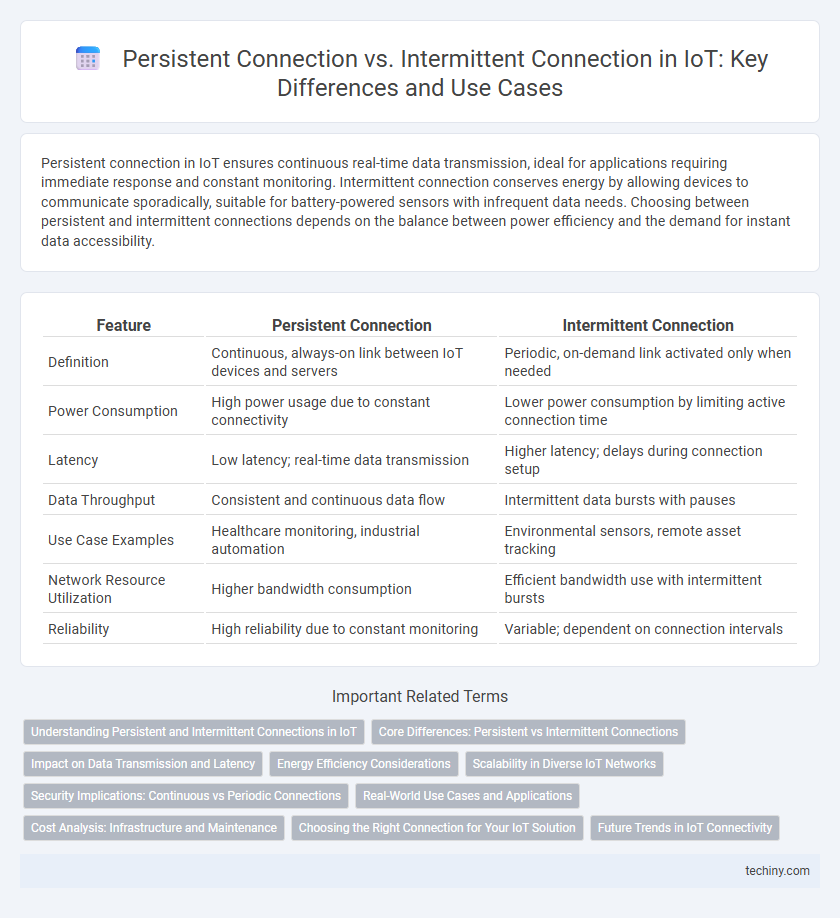Persistent connection in IoT ensures continuous real-time data transmission, ideal for applications requiring immediate response and constant monitoring. Intermittent connection conserves energy by allowing devices to communicate sporadically, suitable for battery-powered sensors with infrequent data needs. Choosing between persistent and intermittent connections depends on the balance between power efficiency and the demand for instant data accessibility.
Table of Comparison
| Feature | Persistent Connection | Intermittent Connection |
|---|---|---|
| Definition | Continuous, always-on link between IoT devices and servers | Periodic, on-demand link activated only when needed |
| Power Consumption | High power usage due to constant connectivity | Lower power consumption by limiting active connection time |
| Latency | Low latency; real-time data transmission | Higher latency; delays during connection setup |
| Data Throughput | Consistent and continuous data flow | Intermittent data bursts with pauses |
| Use Case Examples | Healthcare monitoring, industrial automation | Environmental sensors, remote asset tracking |
| Network Resource Utilization | Higher bandwidth consumption | Efficient bandwidth use with intermittent bursts |
| Reliability | High reliability due to constant monitoring | Variable; dependent on connection intervals |
Understanding Persistent and Intermittent Connections in IoT
Persistent connections in IoT maintain a continuous communication channel between devices and servers, ensuring real-time data transmission and low latency essential for critical applications like healthcare monitoring and industrial automation. Intermittent connections, characterized by periodic data exchange and temporary disconnections, optimize power consumption and bandwidth usage, making them suitable for battery-operated sensors and remote monitoring devices. Understanding the trade-offs between persistent and intermittent connections helps in designing IoT systems that balance responsiveness, energy efficiency, and network reliability.
Core Differences: Persistent vs Intermittent Connections
Persistent connections in the Internet of Things (IoT) maintain a continuous communication link between devices and servers, ensuring real-time data exchange and low latency for critical applications. Intermittent connections, by contrast, operate on an on-demand basis, activating communication only when necessary to conserve energy and bandwidth in resource-constrained environments. The core difference lies in the trade-off between constant connectivity for immediate responsiveness and regulated connectivity aimed at optimizing power consumption and network efficiency.
Impact on Data Transmission and Latency
Persistent connections in Internet of Things (IoT) ensure continuous data transmission, minimizing latency and enabling real-time responsiveness for critical applications such as remote monitoring and industrial automation. Intermittent connections reduce power consumption by transmitting data only at intervals, but this approach introduces higher latency due to connection setup times and data batching delays, which can impact time-sensitive decision-making. Selecting between persistent and intermittent connections depends on balancing energy efficiency with the demands for low-latency data communication in IoT networks.
Energy Efficiency Considerations
Persistent connections in IoT devices typically consume more energy due to continuous data transmission and maintaining active network links, resulting in higher battery drain. Intermittent connections optimize energy efficiency by limiting data exchanges to scheduled intervals or event triggers, significantly extending device battery life. Selecting connection strategies based on device use cases and power constraints is crucial for balancing performance and energy consumption in IoT networks.
Scalability in Diverse IoT Networks
Persistent connections enable real-time data synchronization and low latency communication essential for large-scale IoT deployments but require substantial energy and bandwidth resources that may limit scalability in resource-constrained devices. Intermittent connections reduce power consumption and network congestion by transmitting data in scheduled bursts, enhancing scalability across heterogeneous IoT networks with varying device capabilities and connectivity patterns. Balancing these connectivity models based on application requirements and network conditions is critical to optimizing scalability and performance in diverse IoT ecosystems.
Security Implications: Continuous vs Periodic Connections
Persistent connections in Internet of Things (IoT) devices maintain continuous communication channels, enhancing real-time data transfer but increasing exposure to cyber threats such as unauthorized access and denial-of-service attacks. Intermittent connections reduce vulnerability by limiting active communication windows, yet periodic reconnections can introduce security risks during handshake processes and authentication phases. Implementing robust encryption protocols and secure key management is critical to mitigate risks associated with both continuous and periodic IoT connectivity models.
Real-World Use Cases and Applications
Persistent connections in IoT enable real-time data streaming essential for applications like smart grids and autonomous vehicles, ensuring continuous monitoring and instant response. Intermittent connections are suited for energy-efficient devices such as remote sensors in agriculture and wildlife monitoring, where periodic data transmission conserves battery life. Choosing between persistent and intermittent connections depends on application demands for latency, power consumption, and data criticality.
Cost Analysis: Infrastructure and Maintenance
Persistent connections in IoT require continuous communication channels, leading to higher infrastructure costs due to constant data transmission and more robust hardware. Intermittent connections reduce operational expenses by limiting network usage and minimizing power consumption, which lowers maintenance demands and extends device lifespan. Cost analysis reveals that intermittent connections offer significant savings in large-scale deployments by optimizing energy efficiency and reducing network bandwidth requirements.
Choosing the Right Connection for Your IoT Solution
Persistent connections in IoT enable continuous data flow and real-time monitoring, essential for critical applications like healthcare and industrial automation. Intermittent connections reduce power consumption and are suitable for devices with limited energy resources or non-time-sensitive data transmission. Selecting the right connection depends on factors such as device power capacity, data transmission frequency, latency requirements, and application criticality.
Future Trends in IoT Connectivity
Persistent connections in IoT provide continuous data streams essential for real-time monitoring and control applications, enhancing device responsiveness and reliability. Intermittent connections, optimized for power saving and bandwidth efficiency, cater to low-power wide-area networks and sporadic sensor data transmissions. Future trends in IoT connectivity emphasize hybrid models combining persistent and intermittent connections, leveraging edge computing and 5G technologies to balance performance with energy efficiency.
Persistent Connection vs Intermittent Connection Infographic

 techiny.com
techiny.com